Udaipur city and its understated treasure of arms and armour
Udaipur city and its understated treasure of arms and armour
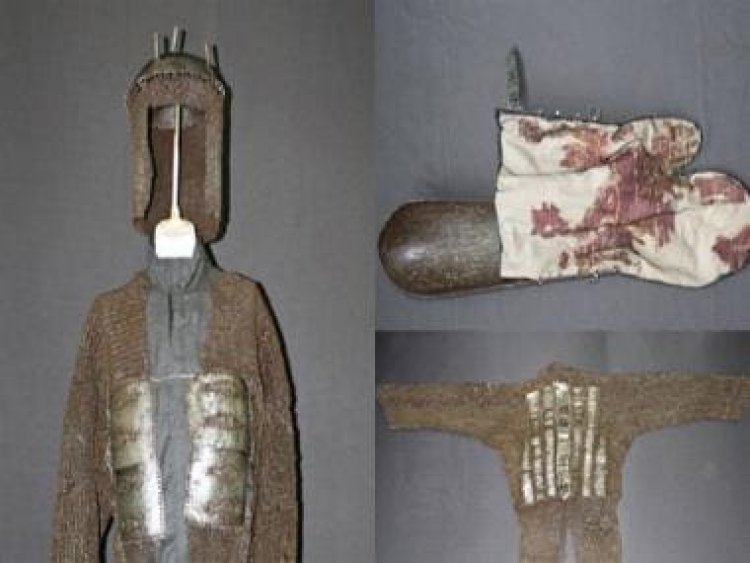
Among the many treasures that are tucked away in the stately halls of the Udaipur City Palace over the centuries: from art and artefacts to textiles, perhaps none is as understated as the collection of arms and armory.
The collection includes a full range of arms and armour from the late 16th to the 20th centuries that express the unique cultural identity of Mewar. In addition to these, it includes south Indian, Mughal, Middle Eastern, European, and American masterpieces.
The most memorable part of the collection is a complete set of horse armour, body armour, sword and shield belonging to the Maharana Pratap (r. 1572–97 CE), the legendary national icon who fought for the independence of Mewar against the mighty Mughal Empire.
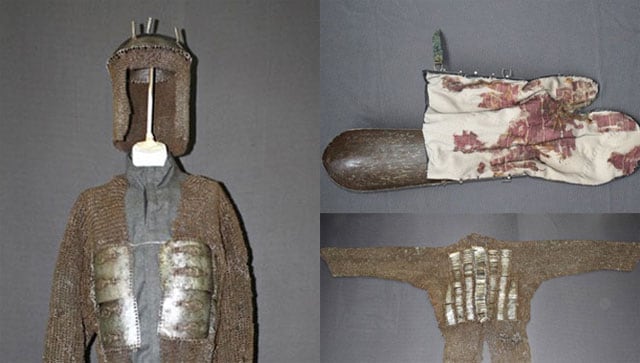
Most of the weapons are stamped with the typical markings of Mewar, while others have more elaborate inscriptions in Devanagari, Arabic, and Nastaliq script. In terms of both quality and diversity, the Udaipur armory is truly unique.
The start of the Saleh Khana
In April 2018, Maharana of Mewar Charitable Foundation established a conservation laboratory in its City Palace Museum, Udaipur to carry out the conservation and restoration of the armory collection, many of which needed repairs due to the vagaries of time.
Located in Chhota Darikhana area of the City museum, built by Maharana Swarup Singh (r. 1842 – 1861 CE) in mid-19th century, its heritage precincts are the ideal setting for the conservation lab.
Hansmukh Seth, Associate Curator at The City Palace Museum notes, “The objective of this major project is to bring the entire collection to a state of conservation that would ensure its longevity and inspire future generations. The systematic approach encompassed documentation, scientific examination, and treatment of each object.”
Over the course of the last four years, more than 1000 items have been restored by the team. They consist of edged weapons (swords, daggers, spears, bayonets, knives, punch daggers and maces), armours (Horse and body armour, helmets, armguards, shields, cuirass and arm-guards), firearms (Guns, Derringers, pistols, miniature pistols andminiature cannons), instruments used during war and ammunition belts with powder flask carriers.
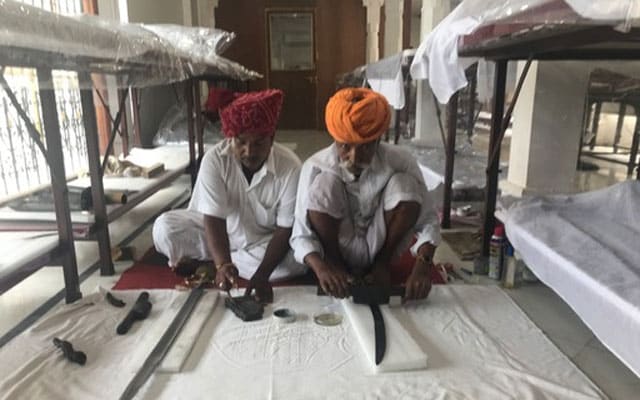
The armory is a portmanteau of ancient craft styles, techniques and metal usage. The arms were crafted depending on the specific usage of metals which included ones like Iron, steel, copper, brass, bronze, Silver, Gold, German silver, lead, nickel for crafting while leather, wood, textile, ivory, jade, bone, precious and semiprecious stones were used for embellishment.
The restoration team is headed by Vandana Singh, Metal Conservator and scientific metallurgical expert from New Delhi who was ably supported by traditional craftsmen from Udaipur.
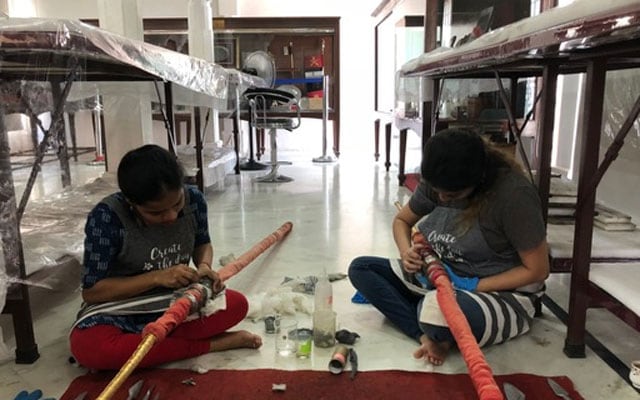
Singh says that this is the first of its kind of lab, combining a team of conservators with material scientists, technicians, and the last remaining traditional metal craftsman of the region. She shares, “The team of craftsmen includes a 90-year-old master swordsmith and an 80-year-old master carpenter, the gun maker, the chainmail maker, and the lacquered shield maker. Working alongside the traditional smiths is an enriching experience and has opened up new ways of understanding age-old practices.”
The steps of conservation
While the arms and armour displayed at the Saleh Khana is overwhelming, the process of conservation is long and at times even arduous. Any object that comes into the lab is first segregated according to its nature, material and preservation status. It is then photographed to ensure that the conversation aspects are carried out accurately.

The object’s material and manufacturing technique is then identified since it determines the deterioration process and the intervention. This task needs detailed analysis of its elements, alloying components, material, superficial texture, consistency, appearance using visual examination and non-destructive analysis.
The most important aspect is the conservation assessment. “It is important to assess the condition of metal objects where corrosion plays a major role. This evaluation can only be done by metal conservator who will judge whether the corrosion is stable or active, and the extent of cleaning.” Singh notes.
Once the assessment is done, the conservation processes begin which includes surface cleaning, polishing, stabilization, passivation, consolidation and protective coating. The final part is the structural repair and restructuring which include necessary repairs to recover the object’s originality and reconstruction (if any) of missing parts.
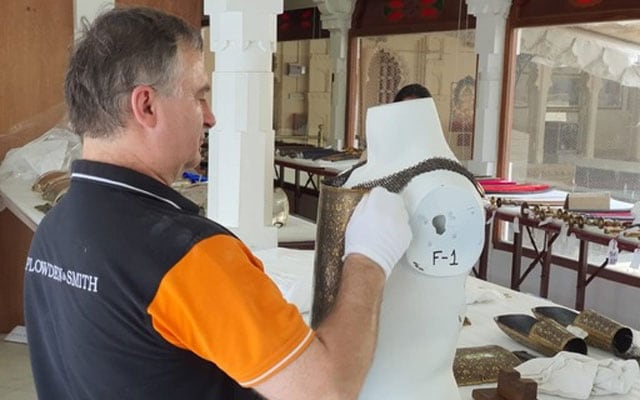
The conservation lab fosters examination, analysis, and research of ancient objects. The focus here is to guarantee the permanence of precious artefacts using expertise, time and talent.
“We apply measures of preventive conservation, remedial conservation, restoration, storage and environmental monitoring that follow the international regulations. These measures range from the control of environmental conditions, delicate handling, proper packaging that does not generate harmful products such as acids.” shares Seth.
The provenance of the artefacts is matched by co-relating them with thehuge treasure trove of paintings and archival materials available at the museum. Other techniques include scientific analysis and by including the local smiths in the restoration process.
The painstaking process of protecting artefacts
A historic armguard, called bazubandh (in Persia) and dastana (in Hindi) used for the protection of forehand, wrist and elbow was conserved in the laboratory. The metallic armguard with textile padding embroidered and silver threads (Zari) was intricately conserved to bring it back to its pristine original form.
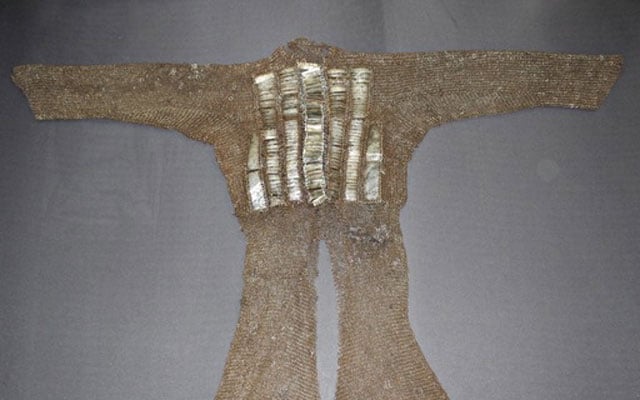
The passage of time resulted in rust, fraying of zari and undesirable strains of iron on textile. This is a classic example of how objects, consisting of composite materials (iron plates, textile, silver embroidery) of different origin and nature, pose major conservation challenges.
Singh and her team worked hard to restore the object. Following non-invasive analyses, the appropriate conservation treatment was followed which involved cleaning the textile with brushing, vacuuming, and specialized rubber and sponges to pick up solid powder, fragments and particle. A new linen support was prepared and small stitches were used to stitch the edges of original and new textile together.
“The added parts were fixed by fine stitches of cotton dyed in the same colour. All the fragile parts that were found was bought together. The scattered weft thread was arranged on its original place using tweezers and soft brush before the re-enforcement procedure.” explains Singh.
Another piece which incorporated the fabled knowledge of traditional Mewari smiths to restore was a body armour also called the Zirah-Bakhtar. The body armour was made of alternative wedge riveted and welded chain rings. The armour had various sizes of body plates to further protect the chest, back, spinal cord and the sides of the upper body. On the back it was composed of 203 body plates connected to iron rings.
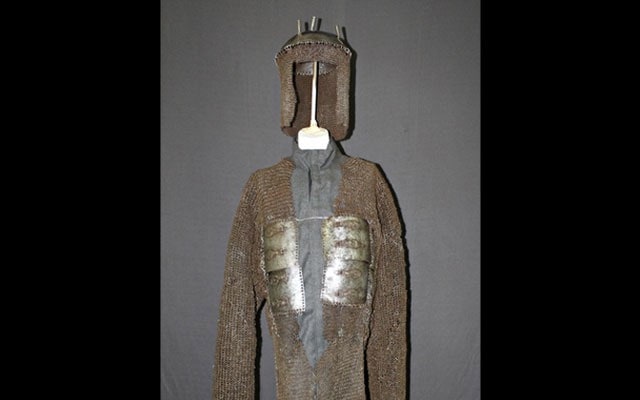
Before conservation, the armour was heavily rusted both inside and out. Inside surfaces appeared to have never been surface coated in any way; bare rust predominated across the whole collection. The metal rings were in a severely deteriorated state such as multiple rings had been lost or partially detached from the structure.
The body armour was nursed back to life by a traditional chain mail maker who was invited to carry out structural repair work. The restoration merged traditional practices, advanced material and conservation skills to conserve magnificent Mewari mail armours.
The importance of conservation
Many of the conserved artefacts will be displayed in the upcoming gallery titled Salehkhana Gallery: Arms and Armoury Exhibition inside the City Museum and rest would be housed in storage as a reserved collection.
The importance of the conservation lab is in its ability to showcase the arts, crafts, techniques and expertise of the mastersmiths of past. Many of the techniques are lost or are no longer relevant but the process of conservation ensures that the traditional knowledge and practices which are in the hands of an aging population and at risk of fading away in the future are preserved.
Read all the Latest News, Trending News, Cricket News, Bollywood News, India News and Entertainment News here. Follow us on Facebook, Twitter and Instagram.
What's Your Reaction?



























































